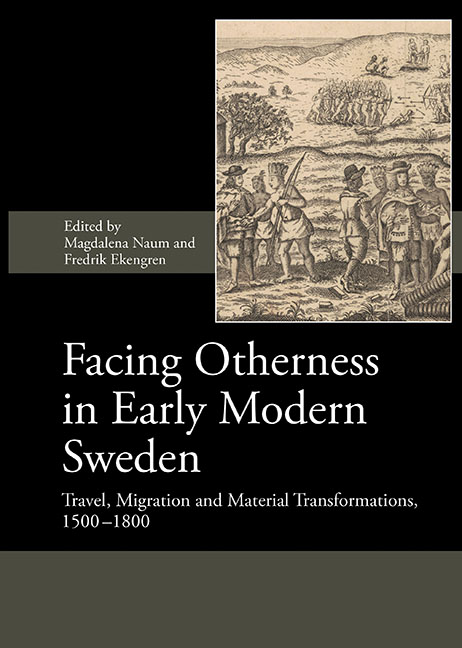Book contents
- Frontmatter
- Contents
- List of Illustrations
- List of Contributors
- Preface
- List of Abbreviations
- I Material Transformations
- II Migration and Neighbourly Interactions
- Introduction
- 6 Marrying “the Other”: Crossing Religious Boundaries in the Eastern Borderlands of the Kingdom of Sweden in the 17th Century
- 7 Ideas from Abroad: German Weavers as Agents of Large-Scale Cloth Production and a Continental Lifestyle in 17th-Century Sweden
- 8 Foreign Merchants in Early Modern Sweden: A Case of Intermarriage, Trade and Migration
- 9 Aspects of “British” Migration to Sweden in the 17th Century
- 10 Commodities, Consumption and Forest Finns in Central Sweden
- 11 Encountering “the Other” in the North – Colonial Histories in Early Modern Northern Sweden
- 12 Lapland's Taxation as a Reflection of “Otherness” in the Swedish Realm in the 17th and 18th Centuries: Colonialism, or a Priority Right of the Sami People?
- III Overseas Travel
- IV Conclusions
- Index
Introduction
from II - Migration and Neighbourly Interactions
Published online by Cambridge University Press: 23 July 2019
- Frontmatter
- Contents
- List of Illustrations
- List of Contributors
- Preface
- List of Abbreviations
- I Material Transformations
- II Migration and Neighbourly Interactions
- Introduction
- 6 Marrying “the Other”: Crossing Religious Boundaries in the Eastern Borderlands of the Kingdom of Sweden in the 17th Century
- 7 Ideas from Abroad: German Weavers as Agents of Large-Scale Cloth Production and a Continental Lifestyle in 17th-Century Sweden
- 8 Foreign Merchants in Early Modern Sweden: A Case of Intermarriage, Trade and Migration
- 9 Aspects of “British” Migration to Sweden in the 17th Century
- 10 Commodities, Consumption and Forest Finns in Central Sweden
- 11 Encountering “the Other” in the North – Colonial Histories in Early Modern Northern Sweden
- 12 Lapland's Taxation as a Reflection of “Otherness” in the Swedish Realm in the 17th and 18th Centuries: Colonialism, or a Priority Right of the Sami People?
- III Overseas Travel
- IV Conclusions
- Index
Summary
Early modern Sweden was a multicultural kingdom. Within its 17th-century borders it included Finland (which was part of the realm since the Middle Ages) as well as Livonia, the German provinces of Bremen-Verden, Wismar and Pomerania, and old Danish regions of Halland, Scania and Blekinge, all acquired in war settlements. In the north, the lands of Sápmi (Lapland) were claimed and colonized with a new vigour at this time. The country also became home to various diasporas: groups of European immigrants who ventured to Scandinavia enticed by a possibility of social advancement, economic profit and a better life. It was furthermore a site of domestic resettlements, of which the most considerable was the movement of the so-called Forest Finns from eastern Finland to central and northern parts of Sweden proper. In many cases the Swedish government looked positively on migration or even sponsored the arrival of newcomers, who were regarded as a crucial ingredient in the ambitious plan to boost the economy and reputation of the country. Their injection of capital, market connections, skills and knowledge were rewarded with privileges, freedoms and various concessions. The expansion of the kingdom, relocations of its subjects and arrival of newcomers brought significant economic, technical and cultural changes. It created novel networks and connections which in turn posed new challenges, not least regarding how to respond to this multitude of cultures and customs, and how to accommodate members of different confessions in a sternly Lutheran kingdom. Even if the flow of people across the borders was not unique to early modern Sweden (but rather part of a contemporary global development of increased mobility, voluntary as well as forced), it nonetheless engendered and required localized responses.
This part of the book describes some of the individuals and groups that moved within the country's borders and who migrated to Sweden making it a temporary or permanent home. It focuses on their cultural strategies and interactions with the Swedish-speaking majority. Several chapters pay attention to borders and, noting their contested character, address questions of daily life in these charged areas, raising the issues of power, transgression and colonial expansion.
- Type
- Chapter
- Information
- Facing Otherness in Early Modern SwedenTravel, Migration and Material Transformations 1500–1800, pp. 107 - 108Publisher: Boydell & BrewerPrint publication year: 2018



